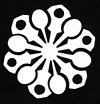 The final tie of Boxelder Week reproduces artwork from the Book of Kells, one of the world's most renowned manuscripts. It was completed around 800 A.D., the work of at least two Irish monks in the monastery of St. Columba on the island of Iona, off Scotland's west coast. The book contains 680 pages of calfskin vellum (an additional 30 have been lost), all but two of which are illustrated, and without any repeat of patterns. Transcribed therein are the four Gospels in Latin and some miscellanea (Hebrew names and the Eusebain canons). The book acquired its name after being moved to Kells Monastery in Ireland in the 9th century, as protection from Viking raids. That didn't stop it from being stolen in 1007, however, though the book was quickly recovered, minus its bejewelled cover. The Book of Kells was given to Trinity College of Dublin in 1661, and remains there today. I'm afraid I couldn't find what the fish and fabulous tracery on this tie depict; Boxelder's Kells line is no longer available, and is not displayed on the website. So if you know, please leave that information in a comment. (I have a feeling the incredibly knowledgeable Mike S. will know...)
The final tie of Boxelder Week reproduces artwork from the Book of Kells, one of the world's most renowned manuscripts. It was completed around 800 A.D., the work of at least two Irish monks in the monastery of St. Columba on the island of Iona, off Scotland's west coast. The book contains 680 pages of calfskin vellum (an additional 30 have been lost), all but two of which are illustrated, and without any repeat of patterns. Transcribed therein are the four Gospels in Latin and some miscellanea (Hebrew names and the Eusebain canons). The book acquired its name after being moved to Kells Monastery in Ireland in the 9th century, as protection from Viking raids. That didn't stop it from being stolen in 1007, however, though the book was quickly recovered, minus its bejewelled cover. The Book of Kells was given to Trinity College of Dublin in 1661, and remains there today. I'm afraid I couldn't find what the fish and fabulous tracery on this tie depict; Boxelder's Kells line is no longer available, and is not displayed on the website. So if you know, please leave that information in a comment. (I have a feeling the incredibly knowledgeable Mike S. will know...)But the big news of the day is, new clothes from Lands' End! Why am I always going on about Lands' End, you ask? (Or not.) Because it's the only place I can get pants that actually fit! You see, the clothing manufacturers have decided that mens' legs are sized in increments of two inches, or that men will be happy with their pants if they are within two inches of the correct length. If you need a 32½ inch inseam, for instance, you are fated to walk around with your pants just a little too short (or worse, if they shrink), or to be walking on your pants hems because 34 inches is just too long. But with Lands' End, you can specify your inseam to the quarter inch! What a luxury, to wear pants with a hem that just breaks over the instep and hangs straight down in back to the midpoint of the shoe.

2 comments:
Somewhere over the years, I heard that the spirals in Celtic illuminated manuscripts were adapted from designs in their metalwork. Also, I believe that on some pages of the Book of kells, the spirals radiate out from or reflect the patterns in the illuminated initials.
Celtic art was distinct from classical Greek and Roman art in that it was not realistic and representational - maybe like Islamic art? The plants and animals are just there, exuberantly.
Of course, in a Christian setting, a fish can likely represent Jesus, but I've always felt that in Celtic art, a fish is just a fish (and a cigar is just a smoke).
Startling idea: illuminated borders in a book were more or less the neckties that the text wears, not all that useful, but who would want to see the text do without them?
Cheers... Mike S.
Thanks, Mike! I knew you would have some illuminating commentary (heh-heh). I love the illustration-necktie parallel!
BV
Post a Comment